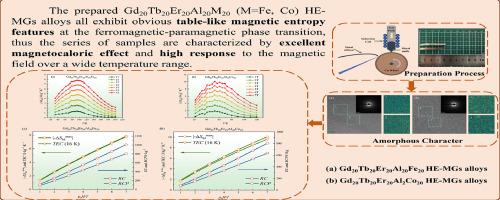Low-temperature magnetic refrigeration in Gd20Tb20Er20Al20M20 (M = Fe, Co) high-entropy metallic glasses
IF 4.6
2区 物理与天体物理
Q1 PHYSICS, MULTIDISCIPLINARY
引用次数: 0
Abstract
This paper focuses on the magnetocaloric effect (MCE) of Gd20Tb20Er20Al20M20 (M = Fe, Co) high-entropy metallic glasses (HE-MGs). XRD and TEM results indicate that both HE-MGs are amorphous. Magnetic studies show that both HE-MGs display spin-glass behavior, undergo a second-order phase transition from ferromagnetic to paramagnetic, and exhibit soft magnetic properties at the Curie temperature (TC). Notable large and broad table-like magnetic entropy change characteristics of Gd20Tb20Er20Al20Fe20 (Gd20Tb20Er20Al20Co20) appear near a TC of 92 (51) K. Hence, under 7 T magnetic field, |-∆SMmax|, ∆ TFWHM, and RCP are 7.83 (10.10) J·kg-1·K-1, 120.07 (71.88) K, and 1008.26 (805.70) J·kg-1, respectively. Furthermore, the modulation of the magnetic and magnetocaloric properties of the samples after substitution of Fe for Co was revealed by the intricate 3d-3d and 3d-4f exchange interactions within the system. The magnetic phase transition critical behaviors in both HE-MGs were analyzed using the scaling law to clarify the deviation of amorphous materials from the mean-field theory. Thus, this study not only highlights the potential of this material for low-temperature magnetic refrigeration applications, but also expands our understanding of its physical properties.

Gd20Tb20Er20Al20M20 (M = Fe, Co) 高熵金属玻璃中的低温磁制冷
本文重点研究了 Gd20Tb20Er20Al20M20(M = Fe、Co)高熵金属玻璃(HE-MGs)的磁致效应(MCE)。XRD 和 TEM 结果表明,两种 HE-MG 都是无定形的。磁性研究表明,这两种 HE-MGs 都显示出自旋玻璃特性,经历了从铁磁性到顺磁性的二阶相变,并在居里温度 (TC) 下显示出软磁特性。因此,在 7 T 磁场下,|-∆SMmax|、∆ TFWHM 和 RCP 分别为 7.83 (10.10) J-kg-1-K-1、120.07 (71.88) K 和 1008.26 (805.70) J-kg-1。此外,用铁代替钴后,样品的磁性和磁致性的变化是由体系内错综复杂的 3d-3d 和 3d-4f 交换相互作用所揭示的。利用缩放定律分析了两种 HE-MG 中的磁相变临界行为,以澄清非晶材料与均场理论的偏差。因此,这项研究不仅凸显了这种材料在低温磁制冷应用方面的潜力,还拓展了我们对其物理性质的理解。
本文章由计算机程序翻译,如有差异,请以英文原文为准。
求助全文
约1分钟内获得全文
求助全文
来源期刊

Chinese Journal of Physics
物理-物理:综合
CiteScore
8.50
自引率
10.00%
发文量
361
审稿时长
44 days
期刊介绍:
The Chinese Journal of Physics publishes important advances in various branches in physics, including statistical and biophysical physics, condensed matter physics, atomic/molecular physics, optics, particle physics and nuclear physics.
The editors welcome manuscripts on:
-General Physics: Statistical and Quantum Mechanics, etc.-
Gravitation and Astrophysics-
Elementary Particles and Fields-
Nuclear Physics-
Atomic, Molecular, and Optical Physics-
Quantum Information and Quantum Computation-
Fluid Dynamics, Nonlinear Dynamics, Chaos, and Complex Networks-
Plasma and Beam Physics-
Condensed Matter: Structure, etc.-
Condensed Matter: Electronic Properties, etc.-
Polymer, Soft Matter, Biological, and Interdisciplinary Physics.
CJP publishes regular research papers, feature articles and review papers.
 求助内容:
求助内容: 应助结果提醒方式:
应助结果提醒方式:


